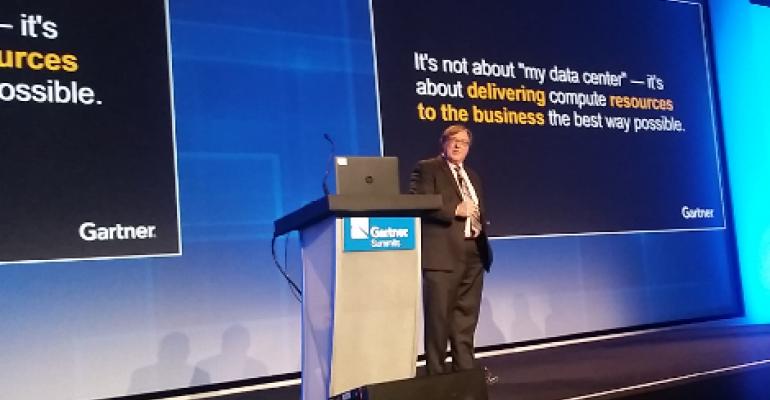LAS VEGAS – Enterprise IT has to forget about hardware, forget about the infrastructure, forget about software, and think more about getting their job done, which is delivering services or applications.
That’s according to David Cappuccio, a VP at Gartner who oversees research in enterprise data center strategies and trends. In the opening keynote at Gartner’s annual data center management summit here Monday, Cappuccio together with colleague Thomas Bittman outlined Gartner’s vision for the new role the IT organization has to play in the enterprise.
That new role has less to do with managing disparate bits of infrastructure and more to do with selecting the best infrastructure strategy to provide a specific service. The toolbox they can select from includes on-premise or colocation data centers and cloud – private, public, or hybrid, on-prem or outsourced.
“The role of IT is shifting to become an intermediary between the customer and the data center and the service provider,” Bittman, a Gartner VP and distinguished analyst, said. “The service provider might be you, but it might be Google, or it might be Salesforce. It comes down to delegating responsibility.”
Gartner expects digital business to drive more and more revenue for enterprises of all kinds, which is why the market research and consulting firm is placing so much importance on an agile, multi-dimensional approach to infrastructure strategy.
Today, digital business capabilities drive 18 percent of enterprise revenue, Raymond Paquet, a managing VP at Gartner, said. The analysts expect that portion to grow to 25 percent in two years and more than double by 2020, reaching 41 percent.
“We (enterprise IT) have the opportunity to lead and work with our businesses to drive this revenue,” he said.
By its nature, the enterprise IT environment today is complex, and it continues growing in complexity as companies release more applications and add more infrastructure components to support them. Some is deployed as cloud services and procured by the business side of the house, while some is set up by IT.
In addition to the primary data center, that environment is likely to include a secondary data center, some colocation space, a disaster recovery site, DR-as-a-Service, branch-office IT, Software-as-a-Service applications, micro data centers in branch offices, social-networking platforms used by staff, and so on.
The big opportunity for IT to add value is to act as a broker and to reduce that complexity for its business users. But their decisions have to be driven with specific application needs in mind:
- Latency
- Reputation
- Service continuity
- Performance
- Security
- Data Protection
- Compliance
- RTO and DR
Taking on this new role is easier said than done. It isn’t a one-time wholesale switch. IT leaders have to sell the new approach to their customers, taking one application and one group of users at a time, documenting the results and advertising them to the rest of the business.
Are you freeing up some time for the users? Are you reducing ineffective use of resources? Measuring and promoting results like that is how IT can convince the business that it can lead and add value, the analysts said.
Ultimately, IT has to change the perception of IT in the business customers’ eyes: IT slows and weighs us down and says ‘no.’ The new perception should be that enterprise IT accelerates time to value, adds value, and protects the enterprise, Bittman said.





